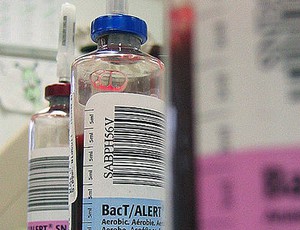Study determines the safety of IV magnesium sulfate infusion

The administration of IV infusion of MgSO4 (4 g/100 mL) in 5% dextrose over a 4-hour treatment period poses no significant deleterious effects on cardiovascular, liver, kidney, or metabolic function” Karhu et al (2018). Abstract: BACKGROUND: Magnesium (Mg) deficiency contributes to the pathophysiology of numerous diseases. The therapeutic use of Mg has steadily increased over […]
Errors in postoperative administration of intravenous patient-controlled analgesia

The findings provide valuable information that can aid in the development of policy and procedures for safer, more effective postoperative administration of IV PCA” Lee et al (2019). Abstract: BACKGROUND: Intravenous patient-controlled analgesia (IV PCA), which typically involves opioids, has become widely used in clinical settings as an effective method of pain management. Identifying errors […]
Anaphylaxis to chlorhexidine-impregnated central venous catheters

We report a case series of anaphylaxis to chlorhexidine-coated central venous catheters (CVCs) when used in cardiac surgical patients in our institution” Baird and Cokis (2019). Abstract: We report a case series of anaphylaxis to chlorhexidine-coated central venous catheters (CVCs) when used in cardiac surgical patients in our institution. Our experience, together with increasing reports […]
Impact on life cycle carbon footprint of converting from disposable to reusable sharps containers

A previous study found that converting from disposable to reusable sharps containers (DSC, RSC) reduced sharps waste stream GHG by 84% but found transport distances impacted significantly on GHG outcomes and recommended further studies where transport distances are large” McPherson et al (2019). Abstract: BACKGROUND: Sustainable purchasing can reduce greenhouse gas (GHG) emissions at healthcare […]
Haemodynamic effects of crystalloid and colloid volume resuscitation

We argue that primary as well as derived and efficiency measures should be reported and discussed when haemodynamic studies are reported involving fluid administrations” Sondergaard et al (2019). Abstract: BACKGROUND: Recent studies in haemodynamic management have focused on fluid management and assessed its effects in terms of increase in cardiac output based on fluid challenges […]
Management of hyperkalemia in the acutely ill patient

To review the mechanisms of action, expected efficacy and side effects of strategies to control hyperkalemia in acutely ill patients” Dépret et al 92019). Abstract: PURPOSE: To review the mechanisms of action, expected efficacy and side effects of strategies to control hyperkalemia in acutely ill patients. METHODS: We searched MEDLINE and EMBASE for relevant papers […]
Stability of the Infliximab following extended storage of the diluted preparation

Physicochemical and biological analyses demonstrated that the infliximab biosimilar PF-SZ-IFX was not affected by extended storage of the diluted preparations used for intravenous infusion” Vimpolsek et al (2019). Abstract: OBJECTIVE: PF-06438179/GP1111 (PF-SZ-IFX) is an infliximab biosimilar. We evaluated the extended in-use physicochemical and biological stability of PF-SZ-IFX upon preparation for intravenous infusion. METHODS: Two batches […]
Scrubbing the hub decontamination for peripheral intravenous catheter care

“This observational study (n = 108) found high compliance with “scrubbing the hub,” although scrub time was shorter than the recommended duration (average 6.1 seconds)” Slater et al (2019).
Procedure for drawing blood cultures through IV catheters

Local guidelines regarding sites for blood culture collection should reflect institution-level blood culture contamination rates for percutaneously-drawn and catheter-drawn cultures using currently available technologies that reduce contamination at both sites” Mermel (2019). Abstract: Studies published between 1999 and 2011 demonstrated increased blood culture contamination with catheter-drawn cultures compared with percutaneously-drawn cultures. Studies published between 2012 […]
Unusual mechanical complications of central venous catheterization

The use of CVC is associated with potential major complications occurring particularly during emergency situations” Katrancioglu (2019). Abstract: To present an unusual major mechanical complication of central venous catheterization (CVC). Methods: Between January 2016 and January 2017, data of the patients who underwent CVC in Cumhuriyet University in Sivas, Turkey, were retrospectively reviewed. The patients […]
Clinical impact of noble metal coated central venous catheters

There was no efficacy of BG-thin noble metal coated CVCs in reducing infectious and non-infectious complications (thrombosis) in our study” Iftikhar et al (2019). Abstract: BACKGROUND: Patients with haematological malignancies and stem cell transplant recipients are at high risk of opportunistic infections. Little international and no national data is available comparing noble metal coated versus […]
Vascular access-related blood-stream infections among Irish haemodialysis patients

Rates of access-related bloodstream infections (AR-BSI) are influenced by patient characteristics and local protocols. We explored factors associated with AR-BSI in a contemporary cohort of HD patients at a tertiary nephrology centre” Mohamed et al (2019). Abstract: BACKGROUND: Infections are the second leading cause of death and hospitalisation among haemodialysis (HD) patients. Rates of access-related […]
Meta-analysis of intracavitary electrocardiogram guidance for PICC placement

The intracavitary electrocardiogram method had a more favorable positioning accuracy versus traditional X-ray method for peripherally inserted central catheter placement in adult patients” Liu et al (2019). Abstract: BACKGROUND: Recently, intracavitary electrocardiogram technology has been applied to peripherally inserted central catheter placement and demonstrates many potential advantages. However, the tip positioning accuracy of intracavitary electrocardiogram […]
Association between intraoperative magnesium sulfate infusion and postoperative AKI

We investigated the association between intraoperative magnesium sulfate infusion and incidence of AKI after major laparoscopic abdominal surgery” Oh et al (2019). Abstract: Magnesium sulfate can be used as a co-adjuvant drug during the perioperative period and has multiple benefits. Recent evidence suggested that perioperative magnesium sulfate infusion may lower the risk of postoperative acute […]
Impact of antibacterial and antibiofilm polyurethane IV catheter coating

In this study, a novel auranofin releasing antibacterial and antibiofilm polyurethane (PU) catheter coating was developed and investigated for future use in preventing CRBSIs” Liu et al (2019). Abstract: Intravascular catheter related bloodstream infections (CRBSIs) are a leading cause of hospital-acquired infections worldwide, resulting not only in the burden of cost and morbidity for patients […]
Tissue plasminogen activator vs heparin for locking central venous catheters

In this study, catheter malfunction rates using recombinant tissue plasminogen activator (rt-PA) vs heparin for locking CVC between apheresis procedures were compared” Mathur et al (2019). Abstract: BACKGROUND: Central venous catheters (CVCs) for apheresis procedures require regular locking/flushes to maintain adequate flow rates. Literature comparing locking solutions for apheresis, where the time interval between procedures […]
Simulation case involves a child with hypovolemic shock who requires IO needle placement

Interns need to be able to recognize critical illness such as hypovolemic shock, obtain access, and manage complications. This simulation case involves a child with hypovolemic shock who requires intraosseous (IO) needle placement” Rideout and Raszka (2018). Abstract: INTRODUCTION: Volume depletion is a common problem in pediatrics. Interns need to be able to recognize critical […]
Efficacy of educational interventions and port protectors on CLABSI

We evaluated efficacy of educational interventions on rate of CLABSIs and effects of port protector as adjuvant tool” Inchingolo et al (2019). Abstract: BACKGROUND: Central Line-Associated BloodStream Infections (CLABSIs) are emerging challenge in Respiratory semi-Intensive Care Units (RICUs). We evaluated efficacy of educational interventions on rate of CLABSIs and effects of port protector as adjuvant […]
Modified glove use for dry contact procedures

We trailed the removal of gloves for contact precautions for contacts not expected to involve body fluids to improve hand hygiene between multiple contacts of the patient and patient zone” Jain et al 92019). Abstract: Background: Patients colonized or infected with methicillin-resistant Staphylococcus aureus and or vancomycin-resistant Enterococcus are placed under contact precautions. Contact precautions […]
Evidence-based practice regarding pediatric central venous catheters

This article highlights the key considerations, pitfalls and evidence-based practices regarding the use pediatric central venous catheters” Jamshidi (2019). Abstract: Central venous catheters (CVC) are commonplace in the management of critically ill patients and serve a variety of purposes. Venous access is important for the administration of fluid and medications as well as blood procurement […]
Infective endocarditis in chronic hemodialysis patients

Patients requiring chronic dialysis are at increased risk for a severe complication such as Infective Endocarditis (IE)” Spaleniak et al (2019). Abstract: Patients requiring chronic dialysis are at increased risk for a severe complication such as Infective Endocarditis (IE). Infections, immediately after cardiovascular diseases, are the second leading cause of deaths in this group of […]
Strategies to avoid intraoperative blood transfusion

This article addresses the current evidence base for correction of preoperative anaemia, normalization of iatrogenic and pathological coagulopathy, intraoperative strategies for optimal blood product usage and management of postoperative anaemia” Swift et al (2019). Abstract: Anaemia and blood transfusion are risk factors in the perioperative setting. Effective management begins preoperatively and should be individualized. This […]
Smart IV pump link to auto-documentation of infusion-therapy services

Smart pump-electronic health record (EHR) interoperability has been demonstrated to reduce adverse events and increase documentation and billing accuracy. However, relatively little is known about the impact of interoperability on infusion therapy billing claims and hospital finances” Suess et al (2019). Abstract: BACKGROUND: Smart pump-electronic health record (EHR) interoperability has been demonstrated to reduce adverse […]
High-alert medication administration and intravenous smart pumps

These findings indicate that the majority of alerts generated are bypassed by clinicians at the point of care, a symptom of alert fatigue” Marwitz et al (2019). Abstract: BACKGROUND: The Institute for Safe Medication Practices (ISMP) describes high alert medications (HAM) as medications that represent a heightened risk of patient harm when used in error. […]
Review of deep vein thrombosis in upper extremities

The prevalence of patients with DVT in upper extremities was 3.0% in the current large-scale real-world registry” Yamashita et al (2019).iv6 Abstract: INTRODUCTION: There is a paucity of data on patients with deep vein thrombosis (DVT) in upper extremities. MATERIALS AND METHODS: The COMMAND VTE Registry is a retrospective multicenter registry enrolling 3027 consecutive patients […]
Parenteral nutrition and oxidant stress in the newborn

There is strong evidence that oxidant molecules from various sources contaminate solutions of parenteral nutrition following interactions between the mixture of nutrients and some of the environmental conditions encountered in clinical practice” Lavoie and Chessex (2019). Abstract: There is strong evidence that oxidant molecules from various sources contaminate solutions of parenteral nutrition following interactions between […]
Nutritional and post-transplantation outcomes of enteral versus parenteral nutrition

This has traditionally been provided via parenteral nutrition (PN), but pediatric evidence is increasingly advocating enteral nutrition (EN) as a preferential alternative” Evans et al (2019). Abstract: BACKGROUND: Hematopoietic stem cell transplantation (HSCT) involves the administration of chemotherapy followed by the infusion of donor stem cells. After treatment, children can consequently experience nausea, vomiting, diarrhea, […]
Relationships to central venous catheters and cardiac implantable devices

The appropriate vascular access for hemodialysis in patients with cardiac implantable electronic devices (CIED) is undefined. We describe two cases of end-stage renal disease patients with CIED and tunneled central venous catheter (CVC) who developed venous cava stenosis” Pacilio et al (2019). Abstract: The appropriate vascular access for hemodialysis in patients with cardiac implantable electronic […]
Mobile device application to reduce medication errors and time to drug delivery

We developed a mobile device application (app) as a step-by-step guide for the preparation to delivery of drugs requiring continuous infusion. The app has been previously tested during simulation-based resuscitations in a previous single-centre trial. In this trial, our aim was to assess this app in various hospital settings” Siebert et al (2019). Abstract: BACKGROUND: […]
Pre-hospital plasma in haemorrhagic shock management

Pre-hospital plasma infusion seems to reduce 24-h mortality in haemorrhagic shock patients” Coccolini ey al (2019). Abstract: BACKGROUND: Trauma-induced coagulopathy is one of the most difficult issues to manage in severely injured patients. The plasma efficacy in treating haemorrhagic-shocked patients is well known. The debated issue is the timing at which it should be administered. […]

